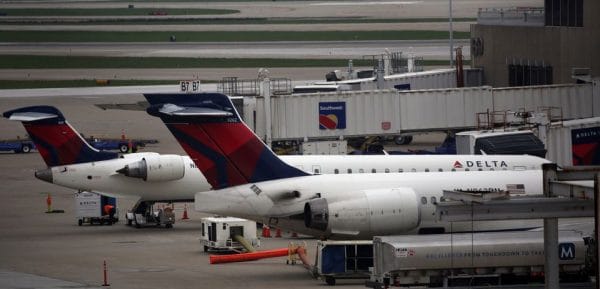The risk of exposure to the coronavirus on flights is so low that in order to breathe in an infectious amount of coronavirus, a passenger would need to fly 54 hours on a plane with an infectious person, a new U.S. Department of Defense study suggests.
The study showed that masks helped lessen exposure to aerosolized coronavirus when someone coughed, even for passengers sitting in neighboring seats. Very little of the virus spreads because of how the air in the plane is circulated and filtered, according to a DOD statement released Thursday.
“Within the scope of the test, the results showed an overall low exposure risk from aerosolized pathogens like COVID-19 on these aircraft,” Vice Admiral Dee Mewbourne, deputy commander of the U.S. Transportation Command, said in a statement.

Very little of the coronavirus spreads on flights because of how the air in the plane is circulated and filtered, according to a Department of Defense statement released Thursday.
(Gus Chan/The Plain Dealer/TNS)
Transportation Command, which operates flights on commercial planes for the military and their families, led and funded the study.
The study assumed that there was only one passenger infected with COVID-19 on the plane and did not simulate passengers moving around the cabin. The research was conducted aboard Boeing 777 and 767 airplanes.
The DOD study did not address how coronavirus might spread on a plane when an infected person is talking or eating.
For the study, mannequins with and without surgical masks were positioned in various seats on an aircraft. Fluorescent tracer particles, used to simulate virus particles, were released every two seconds to simulate breathing, the DOD said. Researchers observed how the particles spread through the air.
Sensors in the cabin represented other passengers and measured particle concentration over time. The DOD study, conducted in August in Nebraska, included 300 tests over eight days.
The aerosol particles were quickly diluted by the high rate of air exchange inside the planes, the DOD said. Tracer particles could be detected within the cabin for less than six minutes, on average. These types of particles would take about 90 minutes to clear from an average American home.
“The high air exchange, coupled with high efficiency particulate air (HEPA) filtration of all recirculated air, means a commercial aircraft’s air supply system provides protection greater than the design standards for a patient isolation room or a hospital operating room,” the DOD said.
Studies about the spread of COVID-19 have swung between reassuring and alarming. One reason might be that early studies looked at examples that took place before mask wearing was commonplace.
A German study published in August dealt with a 4-hour, 40-minute flight last March carrying 102 passengers, none of whom was wearing a mask. Seven passengers, part of a tour group of 24 people, were unaware they had the virus. Researchers found just two new cases, both passengers who had sat near the seven already infected people.
COVID-19 was probably transmitted from two passengers to two crew members on a 15-hour flight from Boston to Hong Kong on March 9, according to a study published in Emerging Infectious Diseases.
A 10-hour flight from London to Hanoi in March resulted in 15 people testing positive for COVID-19 because they flew with an infected person, suggested a Vietnamese-Australian study published in the journal Emerging Infectious Diseases.
___
(c) 2020 The Plain Dealer
Distributed by Tribune Content Agency, LLC.



